【资料】道路平纵横设计概要汇编
- 格式:ppt
- 大小:1.46 MB
- 文档页数:68
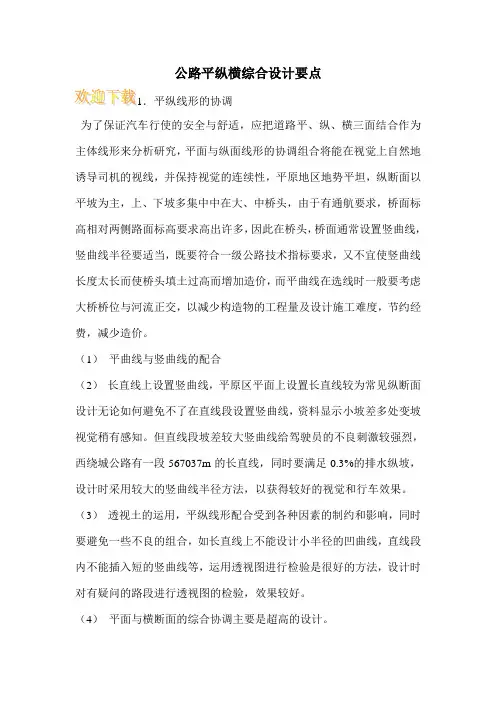
公路平纵横综合设计要点.平纵线形的协调为了保证汽车行使的安全与舒适,应把道路平、纵、横三面结合作为主体线形来分析研究,平面与纵面线形的协调组合将能在视觉上自然地诱导司机的视线,并保持视觉的连续性,平原地区地势平坦,纵断面以平坡为主,上、下坡多集中中在大、中桥头,由于有通航要求,桥面标高相对两侧路面标高要求高出许多,因此在桥头,桥面通常设置竖曲线,竖曲线半径要适当,既要符合一级公路技术指标要求,又不宜使竖曲线长度太长而使桥头填土过高而增加造价,而平曲线在选线时一般要考虑大桥桥位与河流正交,以减少构造物的工程量及设计施工难度,节约经费,减少造价。
(1)平曲线与竖曲线的配合(2)长直线上设置竖曲线,平原区平面上设置长直线较为常见纵断面设计无论如何避免不了在直线段设置竖曲线,资料显示小坡差多处变坡视觉稍有感知。
但直线段坡差较大竖曲线给驾驶员的不良刺激较强烈,西绕城公路有一段567037m的长直线,同时要满足0.3%的排水纵坡,设计时采用较大的竖曲线半径方法,以获得较好的视觉和行车效果。
(3)透视土的运用,平纵线形配合受到各种因素的制约和影响,同时要避免一些不良的组合,如长直线上不能设计小半径的凹曲线,直线段内不能插入短的竖曲线等,运用透视图进行检验是很好的方法,设计时对有疑问的路段进行透视图的检验,效果较好。
(4)平面与横断面的综合协调主要是超高的设计。
2.线形与环境的协调(1)定线时尽量避开村镇等居民区,减少噪音对居民生活带来的影响,同时采用柔性,沥青混凝土路面以减少噪音。
(2)路基用土由地方政府同意安排,利用开挖鱼塘或沟渠,避免乱开挖,同时又利于农田、水利建设。
(3)注意绿化,对路基边坡及中央分隔带加强绿化和防护,在护坡道上互通立交用地范围内的空地上均考虑绿化。
(4)对位置适当的桥梁在台前坡脚(常水位以下)设置平台,以利非机动车辆和行人通过。
(5)对位于公路两侧的建筑物建议注意其风格,以求和道路想协调,增加美感。
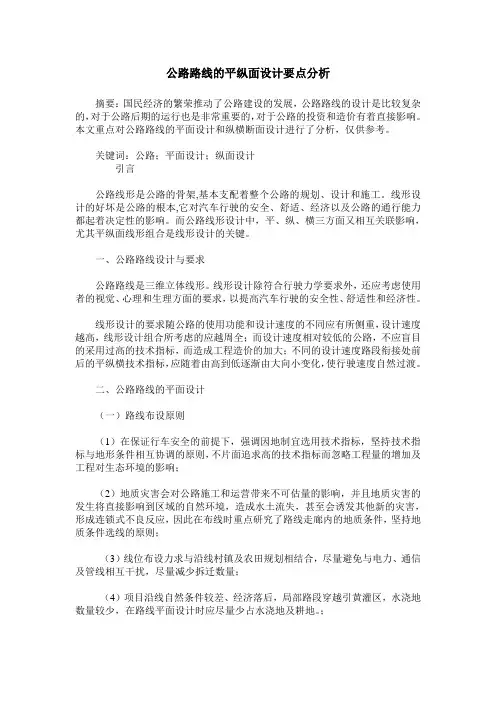
公路路线的平纵面设计要点分析摘要:国民经济的繁荣推动了公路建设的发展,公路路线的设计是比较复杂的,对于公路后期的运行也是非常重要的,对于公路的投资和造价有着直接影响。
本文重点对公路路线的平面设计和纵横断面设计进行了分析,仅供参考。
关键词:公路;平面设计;纵面设计引言公路线形是公路的骨架,基本支配着整个公路的规划、设计和施工。
线形设计的好坏是公路的根本,它对汽车行驶的安全、舒适、经济以及公路的通行能力都起着决定性的影响。
而公路线形设计中,平、纵、横三方面又相互关联影响,尤其平纵面线形组合是线形设计的关键。
一、公路路线设计与要求公路路线是三维立体线形。
线形设计除符合行驶力学要求外,还应考虑使用者的视觉、心理和生理方面的要求,以提高汽车行驶的安全性、舒适性和经济性。
线形设计的要求随公路的使用功能和设计速度的不同应有所侧重,设计速度越高,线形设计组合所考虑的应越周全;而设计速度相对较低的公路,不应盲目的采用过高的技术指标,而造成工程造价的加大;不同的设计速度路段衔接处前后的平纵横技术指标,应随着由高到低逐渐由大向小变化,使行驶速度自然过渡。
二、公路路线的平面设计(一)路线布设原则(1)在保证行车安全的前提下,强调因地制宜选用技术指标,坚持技术指标与地形条件相互协调的原则,不片面追求高的技术指标而忽略工程量的增加及工程对生态环境的影响;(2)地质灾害会对公路施工和运营带来不可估量的影响,并且地质灾害的发生将直接影响到区域的自然环境,造成水土流失,甚至会诱发其他新的灾害,形成连锁式不良反应,因此在布线时重点研究了路线走廊内的地质条件,坚持地质条件选线的原则;(3)线位布设力求与沿线村镇及农田规划相结合,尽量避免与电力、通信及管线相互干扰,尽量减少拆迁数量;(4)项目沿线自然条件较差、经济落后,局部路段穿越引黄灌区,水浇地数量较少,在路线平面设计时应尽量少占水浇地及耕地。
;(5)紧紧围绕“安全、环保、舒适、和谐”的设计理念,平面布设时注重高速公路与周围自然环境协调,减少对生态环境、人文景观的破坏,防止水土流失;(6)考虑现有路网布局与本项目的关系,充分利用现有道路资源,考虑长远发展规划;(二)纸上定线1、在地形图上比例为1∶10000的情况下,在控制区域内对整个路线的布局进行研究,获取中间控制点。

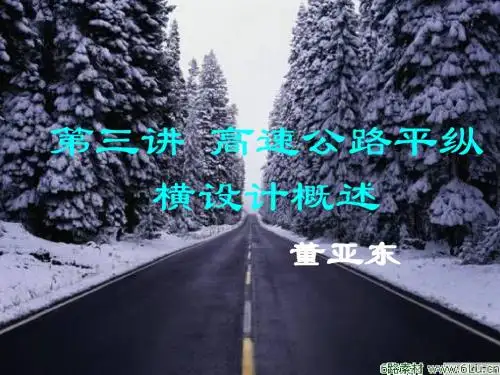
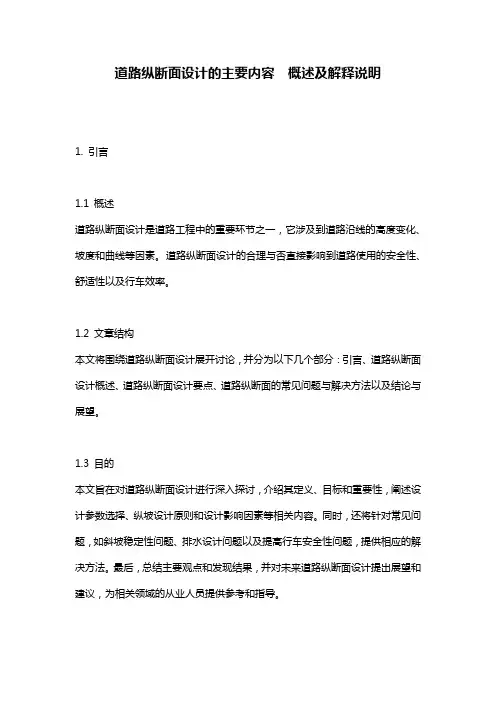
道路纵断面设计的主要内容概述及解释说明1. 引言1.1 概述道路纵断面设计是道路工程中的重要环节之一,它涉及到道路沿线的高度变化、坡度和曲线等因素。
道路纵断面设计的合理与否直接影响到道路使用的安全性、舒适性以及行车效率。
1.2 文章结构本文将围绕道路纵断面设计展开讨论,并分为以下几个部分:引言、道路纵断面设计概述、道路纵断面设计要点、道路纵断面的常见问题与解决方法以及结论与展望。
1.3 目的本文旨在对道路纵断面设计进行深入探讨,介绍其定义、目标和重要性,阐述设计参数选择、纵坡设计原则和设计影响因素等相关内容。
同时,还将针对常见问题,如斜坡稳定性问题、排水设计问题以及提高行车安全性问题,提供相应的解决方法。
最后,总结主要观点和发现结果,并对未来道路纵断面设计提出展望和建议,为相关领域的从业人员提供参考和指导。
2. 道路纵断面设计概述2.1 定义道路纵断面设计是指在规划和建设道路时,根据地形条件及相关要求,对道路的纵向剖面进行设计和布置的过程。
纵断面设计包括确定路线、坡度、曲线和高差等参数,以达到安全、平稳、顺畅的交通运行,并满足排水、景观和环境保护等要求。
2.2 目标道路纵断面设计的主要目标是保证道路在不同地形条件下的平稳度和安全性。
设计应考虑车辆行驶舒适度、减少对驾驶人员的视觉疲劳,尽量减少刹车距离并提高车辆通过性能。
此外,还应兼顾行车速度和径流速度之间的综合关系,确保排水效果良好。
2.3 重要性道路纵断面设计对交通运行的安全和效率影响重大。
合理的纵断面设计不仅可以提高车辆通过道路的舒适度和安全性,还能促进交通流畅并降低事故风险。
同时,在自然环境方面,科学合理的盖地工程施工设计有助于保护自然景观、减轻环境污染并提升道路的临街美观度。
因此,在道路规划和设计过程中,应充分重视纵断面设计的概念和要素,确保道路在各种条件下具备良好的可行性和实用性。
3. 道路纵断面设计要点:3.1 设计参数选择:在道路纵断面设计中,需要考虑多个参数来满足道路使用的要求。
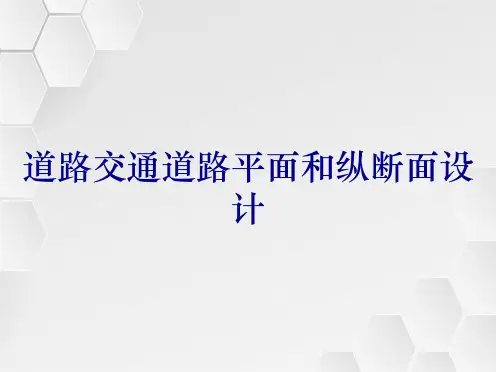
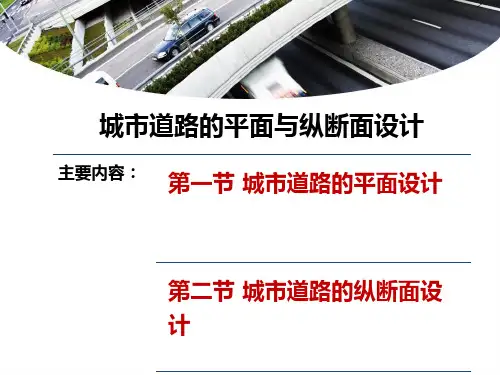
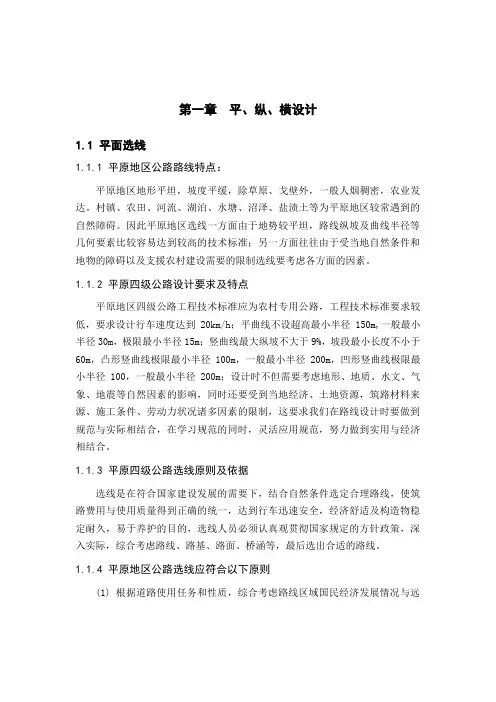
第一章平、纵、横设计1.1 平面选线1.1.1 平原地区公路路线特点:平原地区地形平坦,坡度平缓,除草原、戈壁外,一般人烟稠密,农业发达。
村镇、农田、河流、湖泊、水塘、沼泽、盐渍土等为平原地区较常遇到的自然障碍。
因此平原地区选线一方面由于地势较平坦,路线纵坡及曲线半径等几何要素比较容易达到较高的技术标准;另一方面往往由于受当地自然条件和地物的障碍以及支援农村建设需要的限制选线要考虑各方面的因素。
1.1.2 平原四级公路设计要求及特点平原地区四级公路工程技术标准应为农村专用公路,工程技术标准要求较低,要求设计行车速度达到20km/h;平曲线不设超高最小半径150m,一般最小半径30m,极限最小半径15m;竖曲线最大纵坡不大于9%,坡段最小长度不小于60m,凸形竖曲线极限最小半径100m,一般最小半径200m,凹形竖曲线极限最小半径100,一般最小半径200m;设计时不但需要考虑地形、地质、水文、气象、地震等自然因素的影响,同时还要受到当地经济、土地资源,筑路材料来源、施工条件、劳动力状况诸多因素的限制,这要求我们在路线设计时要做到规范与实际相结合,在学习规范的同时,灵活应用规范,努力做到实用与经济相结合。
1.1.3 平原四级公路选线原则及依据选线是在符合国家建设发展的需要下,结合自然条件选定合理路线,使筑路费用与使用质量得到正确的统一,达到行车迅速安全,经济舒适及构造物稳定耐久,易于养护的目的,选线人员必须认真观贯彻国家规定的方针政策,深入实际,综合考虑路线、路基、路面、桥涵等,最后选出合适的路线。
1.1.4 平原地区公路选线应符合以下原则(1) 根据道路使用任务和性质,综合考虑路线区域国民经济发展情况与远景规划,正确处理好近期与远景的关系,在总体规划的知道下,合理选择方案。
(2) 认真领会任务书的精神,深入现场,多跑、多看、多问、多比较,深入调查当地的地形、气候、土壤、水文等自然情况,以利于选择有价值的方案进行比较。
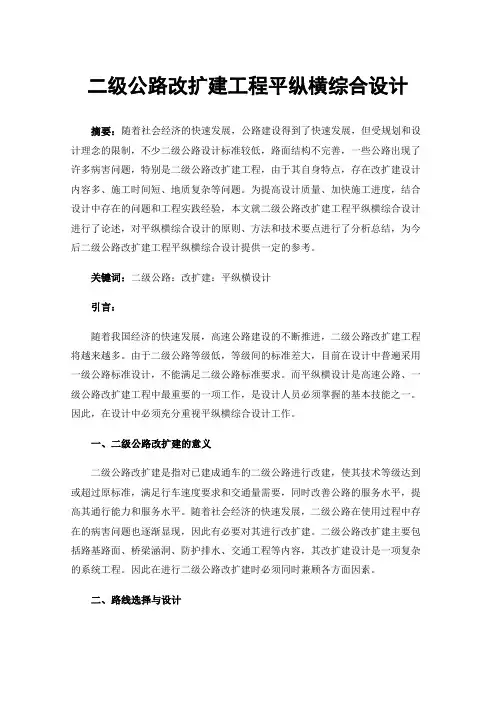
二级公路改扩建工程平纵横综合设计摘要:随着社会经济的快速发展,公路建设得到了快速发展,但受规划和设计理念的限制,不少二级公路设计标准较低,路面结构不完善,一些公路出现了许多病害问题,特别是二级公路改扩建工程,由于其自身特点,存在改扩建设计内容多、施工时间短、地质复杂等问题。
为提高设计质量、加快施工进度,结合设计中存在的问题和工程实践经验,本文就二级公路改扩建工程平纵横综合设计进行了论述,对平纵横综合设计的原则、方法和技术要点进行了分析总结,为今后二级公路改扩建工程平纵横综合设计提供一定的参考。
关键词:二级公路:改扩建:平纵横设计引言:随着我国经济的快速发展,高速公路建设的不断推进,二级公路改扩建工程将越来越多。
由于二级公路等级低,等级间的标准差大,目前在设计中普遍采用一级公路标准设计,不能满足二级公路标准要求。
而平纵横设计是高速公路、一级公路改扩建工程中最重要的一项工作,是设计人员必须掌握的基本技能之一。
因此,在设计中必须充分重视平纵横综合设计工作。
一、二级公路改扩建的意义二级公路改扩建是指对已建成通车的二级公路进行改建,使其技术等级达到或超过原标准,满足行车速度要求和交通量需要,同时改善公路的服务水平,提高其通行能力和服务水平。
随着社会经济的快速发展,二级公路在使用过程中存在的病害问题也逐渐显现,因此有必要对其进行改扩建。
二级公路改扩建主要包括路基路面、桥梁涵洞、防护排水、交通工程等内容,其改扩建设计是一项复杂的系统工程。
因此在进行二级公路改扩建时必须同时兼顾各方面因素。
二、路线选择与设计路线选择是公路设计的首要任务,是对原线进行评估和补充的基础,也是进行总体设计的关键环节。
路线选择应遵循以下原则:(1)符合国家及行业有关技术标准,力求与区域路网相适应;(2)充分利用原有路基、路面结构,避免重复建设;(3)充分利用旧路路基及路面结构,减少开挖路堑、填筑路基、翻修路面等建设内容;(4)结合当地实际情况,尽量利用原有桥梁、隧道或利用桥梁、隧道与原有道路合并布设;(5)路线平曲线半径、超高与加宽的设置应满足行车要求,减少安全隐患;(6)最大限度地保持原有自然景观的连续性,尽量少占或不占农田和林地,以减少工程占地。
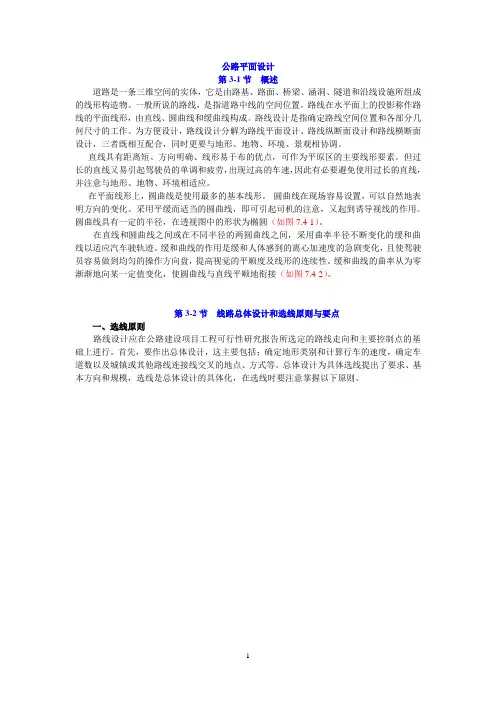
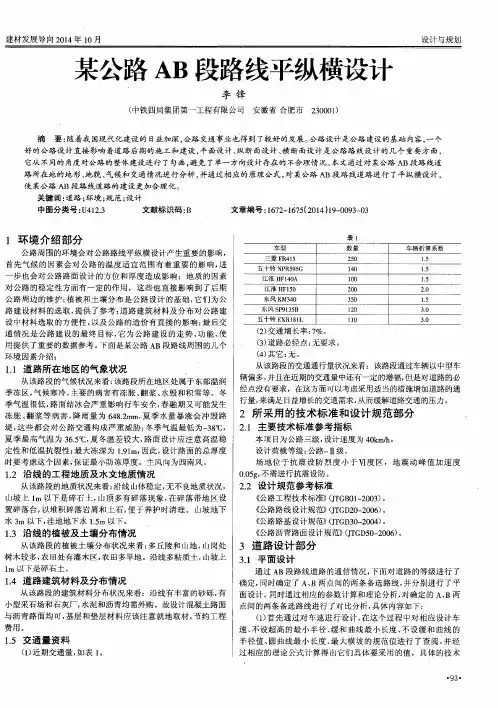
2020年上海市松江七中高三英语二模试卷及参考答案第一部分阅读(共两节,满分40分)第一节(共15小题;每小题2分,满分30分)阅读下列短文,从每题所给的A、B、C、D四个选项中选出最佳选项AOver the years, I’ve been guilty of hastily shutting the front door to many strangers when they came knocking with the intention of selling things. But earlier this year, around Easter time, a dear friend of mine had an experience that changed my mind and perception towards these “intruders”.Linda, who recently moved to a new neighbour hood, had been housebound all week suffering from a severe case of flu when, early one morning, there was the terrible knock on her front door. Peering out the window, she saw two young ladies demurely (端庄地) holding leaflets and a TV set model. She knew of a large TV set establishment nearby and assumed a message was about to be gently delivered. “This is the last thing I need today,” she muttered to herself and hesitantly opened the door.Coughing, she poked her head out and impatiently informed them she wasn’t the slightest bit interested in any TV whatsoever. Furthermore, she added, she was feeling quite unwell and abruptly shut the door. The ladies politely turned and left in silence.A few hours later, another knock. Linda glanced out the window and to her surprise, there were the same two ladies, back again. Really annoyed this time, she opened the door ready togive them a piece of her mind. Before she could speak, with concerned looks on their faces, these women handed Linda what looked to be a dish, saying, “We’re so sorry we disturbed you earlier. We thought you may like this homemade chicken soup. Hopefully it might make you feel a little better.”Linda was taken aback by this lovely gesture. Being new to the area, she didn’t know many neighbours or people who could assist her with shopping or errands (跑腿) so the gesture was all the more appreciated. She could only smile sheepishly and sincerely thanked them. With that, the ladies left.After she related this story to me, I thought about how touching this deed really was. Especially in today’s world where sadly, kindness and thoughtfulness seem so rare. I also realized that thinking about others and showing kindness is the real essence of love.1. What does the expression “give them a piece of her mind”in Paragraph 4 mean?A. Scold them severely.B. Drive them away.C. Refuse them directly.D. Speak out her idea.2. What can be learned about Linda from the passage?A. Linda always hastily shut the front door to many people.B. Linda was not a little interested in any TV whatsoever.C. Linda was very grateful to the ladies for their chicken soup.D. Linda would buy their TV set in reward for the ladies’ chicken soup.3. What’s the best title for the passage?A. A Chicken SoupB. Soup for the soulC. The Real Essence of LoveD. A Friend’s experienceBMany cars in advertisements and on exhibition in the United States are red, blue or green, but almost 75 percent of new cars sold in the United States are black, white, silver orgray.Les Jackson is a reporter who writes about cars. He says the color1 s of cars Americans choose do not show dirt. He says that means the owners wash their cars less in order to save money. And he notes some areas that are suffering from water shortages do not permit people to wash their cars often.Dan Benton works for a company called Axalta, which makes supplies for international car makers. He says white cars are often sold more expensive than cars of other color1 s. And he notes that white cars “absorb(吸收)less energy” than cars of other color1 s. This means temperatures inside them are lower in warmer areas. Benton also says research at Monash University in Australia suggests that there is a lower risk of crashes during the day for white cars compared with darker ones.Car buyers in other countries also like white. Jane Harrington works for PPG Industries, a company that makes paint for cars. She said in China, buyers say white makes a small car look bigger.About 11 percent of cars sold in North America are red and 8 percent are blue. Green has become less popular. Benton notes that in the mid-1990s green was the most popular color1 in North America. Today, green is hard to find.Sometime in the future, people may not have to choose the color1 of their cars —— technology may let owners change their cars’ paint color1 anytime.4. What can we learn from Paragraph 2?A. Most Americans don’t like red cars.B. People in America are not allowed to wash their cars.C. Many people prefer to choose white cars in America.D. Americans may consider the cost of cleaning when choosing cars.5. Why do many people choose white cars?A. They are much cheaper than cars of other color1 s..B. They are much safer while crashing.C. They are bigger than cars of other color1 s.D. They are more comfortable inside in warmer areas.6. What do we know from the text?A. Les Jackson is a member of Axalta.B. Most Americans rarely wash their cars.C. PPG Industries mainly produces cars in China.D. Green cars were once popular in North America.7. What does the text mainly tell us?A. Choices of car color1 sB. How to buy a good car.C. Differences of car color1 s.D. Popular car color1 s in history.CSurfing the Internet for fun will make you a better employee, according to an Australian study.The University of Melbourne study shows that people who use the Internet for their own reasons at work are about 9 percent more productive than those who do not. Study author Brent Coker said, “Surfing the Internet at times helps increase an employee's attention.”“People need to relax for a bit to get back their attention,” Coker said on the university's website. “Having a short break, such as a quick surfing of the Internet, helps the mind to rest itself, leading to a higher total Internet attention for a day's work, and as a result, increases productivity (生产效率),” he said.According to the study of 300 workers, 70 percent of people who use the Internet at work surf the Internet for their own reasons during office hours. Among the most popular surfing activities are searching for information about products, reading online news, playing online games and watching videos. “Firms spend a lot of money on software toblocktheir employees from watching videos, using social networking sites or shopping online,” said Coker. “That's not always a good idea.”However, Coker said the study looked at people who surfed the Internet in moderation (适度), or were on the Internet for less than 20 percent of their total time in the office. “Those who spend too much time surfing the Internet will have a lower productivity than those without.” he said.8. What does the University of Melbourne study mainlyshow?A. People who surf the Internet are good employees.B. Not everyone surfs the Internet for fun during office hours.C. The Internet is becoming more and more important in people's life.D. Surfing the Internet for fun at times during office hours increases productivity.9. Which of the following is NOT mentioned in the passage as one of the most popular surfing activities?A. Watching videos.B. Reading online news.C. Reading online novels.D. Playing online games.10. The underlined word “block” in Paragraph 4 means “________”.A. stopB. organizeC. protectD. separate11. What can we infer from the last paragraph?A. Those who never surf the Internet have the lowest productivity.B. Spending too much time surfing the Internet reduces productivity.C. Most people don't surf the Internet in moderation during office hours.D. People should spend as little time as possible surfing the Internet.DWhen you walk with a backpack, do you know how the things inside move from side to side? Now scientists havefigured out how to tap into that movement to produce electricity.Picture a pendulum (摆锤) fixed to a backpack frame and stabilized with springs on either side. The pack’s weight is attached to the pendulum, so the pendulum swings side to side as you walk.Then a machine is driven by that swinging movement, and spits out electrical current to charge a battery.Volunteers carried the pack while walking on a running machine and wore masks to measure the flow of O2and CO2. Walking with the slightly swinging 20-pound load, the device (设备) did not significantly affect the volunteers’ metabolic (新陈代谢的) rate compared to when they carried the same weight fixed in place. In fact, the energy-harvesting pack reduced the forces of acceleration they’d feel in a regular pack, which might mean greater comfort for a long hike. And the device did produce a steady trickle (涓流) of electricity. If you up the load to 45 pounds, the swing of the pack could fully charge a smart phone only after 12 hours. The details are in thejournal Royal Society Open Science.The device produces electricity from human movement and has been identified as a workable solution to providing a renewable energy source for portable electronic devices. It is particularly useful for those who work in remote areas, as these people often carry a lot of weight in a backpack for their exploration.But here’s a realconundrum: the energy-harvesting device currently weighs five pounds. The researchers say that’s about four pounds too many to be a smart alternative to batteries. So they hope that more research lets them lighten the load, to ensure the pack charges you up without weighing you down.12. What does Paragraph 2 mainly talk about?A. How the device works.B. What the device looks like.C. Who the device is designed for.D. Why scientists designed the device.13. Which of the following describes the device?A. It greatly affected the volunteers metabolic rate.B. It harvested energy as the volunteers walk.C. It failed to produce steady electricity.D. It was useless for a long walk.14. What does the underlined word “conundrum” in the last paragraph mean?A. Problem.B. Method.C. Bond.D. Decision.15. What will the researchers try to do next?A. Increase the charging speed of their device.B. Find smarter alternatives to batteries.C. Reduce the weight of their device.D. Put their device on the market.第二节(共5小题;每小题2分,满分10分)阅读下面短文,从短文后的选项中选出可以填入空白处的最佳选项。
一、视觉分析1.视觉分析的意义道路设计除应考虑自然条件、汽车行驶力学的要求外,还要考虑驾驶人员的心理和视觉上的反应。
视觉是连接道路与汽车的重要媒介。
从视觉心理出发,对道路的空间线形及其与周围自然景观和沿线建筑的协调等进行研究分析,以保持视觉的连续性,使行车具有足够的舒适感和安全感的综合设计称为视觉分析。
2.视觉与车速的动态规律驾驶员的视觉判断能力与车速密切相关,车速越高,其关注前方越远,视野越窄。
3.视觉评价方法所谓线形状况是指道路平面和纵面线形所组成的立体形状,在汽车快速行驶中给驾驶员提供的连续不断的视觉印象。
评价方法主要有三位动态模拟技术和透视图法。
透视图是按照汽车在道路上的行驶位置,根据线形的几何状况确定视轴方向以及由车速确定的视轴长度,利用坐标透视的原理绘制的。
通过透视图,可以看出立体线形是否顺适,是否有易产生判断错误或茫然的地方,路旁障碍是否妨碍视线等。
二、道路平、纵线形组合设计(一)设计原则1.视觉上自然引导驾驶员视线,保持连续性;2.平、纵线形技术指标大、小均衡;3.得当的合成坡度;4.与环境的配合、协调。
(二)线形组合的形式平纵线形有以下六种组合形式1.平面上为直线,纵面也是直线—构成具有恒等坡度的直线;2.平面上为直线,纵面上是凹形竖曲线—构成凹下去的直线;3.平面上为直线,纵面上是凸形竖曲线—构成凸起的直线;4.平面上为曲线,纵面上为直线—构成具有恒等坡度的平曲线;5.平面上为曲线,纵面上为凹形竖曲线—构成凹下去的平曲线;6.平面上为曲线,纵面上为凸形竖曲线—构成凸起的平曲线。
(三)平曲线与竖曲线组合的基本要求1.平曲线与竖曲线应相互重合,且平曲线应稍长于竖曲线;这种组合是使平曲线和竖曲线对应,最好使竖曲线的起终点分别放在平曲线的两个缓和曲线内,即所谓的“平包竖”。
如图4-12所示。
对于等级较高的道路应尽量做到这种组合,并使平、竖曲线半径都大一些才显得协调,特别是凹形竖曲线处车速较高,二者半径更应大一2.平曲线与竖曲线大小应保持均衡;平曲线和竖曲线其中一方大而平缓,另一方就不要形成多而小。
(二)纵断面设计1、设计要求.纵断面线形设计主要是解决公路线形在纵断面上的位置,形状和尺寸问题,具体内容包括纵坡设计和竖曲线设计两项。
纵断面线形设计应根据公路的性质、任务、等级和地形、地质、水文等因素,考虑路基稳定,排水及工程量等的要求对纵坡的大小,长短,前后的纵坡情况,竖曲线半径大小及与平面线形的组合关系等进行组合设计,从而设计出纵坡合理,线形平顺圆滑的最优线形,以达到行车安全、快速、舒适,工程造价省,运营费用较少的目的。
该路地处平原区,土地资源宝贵,本项纵断面设计采用小纵坡,微起伏与该区域农田相结合,尽量降低路堤高度,路线纵断面按百年一遇,设计洪水位的要求和确保路基处于干燥和中湿状态,所需的最小填筑高度来控制标高线形设计上避免出现断背曲线,反向竖曲线之间直线长度不足3秒行程的则加大竖曲线半径,使竖曲线首尾相接。
此外,所选用的半径还满足行车视距的要求,竖曲线的纵坡最小采用0.3%以保证排水要求。
2、纵坡设计(1)纵坡设计的一般要求:①纵坡设计必须满足《标准》的有关规定,一般不轻易使用极限值②纵坡应力求平缓,避免连续陡坡,过长陡坡和反坡③纵断面线形应连续,平顺,均衡,并重视平纵面线形的组合(2)从行车安全,舒适和视觉良好的要求来看,要求纵断面线形注意有以下几点:①在短距离内应避免线形起伏,易使纵断面线形发生中断,视觉不良;避免“凹陷”路段,若线形发生凹陷出现隐蔽路段,使驾驶员视觉不适,产生莫测感,影响行车速度和安全;②在较大的连续上坡路段,宜将最陡的纵坡放在底部,接近顶部的纵坡宜放缓些;③纵坡变化小的,宜采用较大的竖曲线半径;④纵断面线形设计应注意与平面线形的关系,汽车专用公路应设计平、纵面配合良好协调的立体线形;(3)纵坡设计应结合沿线自然条件综合考虑,为利于路面和边沟排水,一般情况下最小纵坡以不小于0.5%为宜,在受洪水影响的沿河路线及平原区低速路段应保证路线的最低标高,以免遭受洪水冲刷,而确保路基的稳定;(4)纵坡设计应争取填、挖平衡,尽量利用挖方作就近填方,以减少借方和废方,接生土石方量,降低工程造价;(5)纵坡设计时,还应结合我国情况,适当照顾当地民间运输工具,农业机械、农田水利等方面的要求。
城市道路设计标准常用数据表格基本规定非机动车设计车辆及其外廓尺寸道路最小净高横断面一条非机动车道宽度平面和纵断面平曲线与圆曲线最小长度最大超高横坡度停车视距竖曲线最小半径与最小长度平、纵、横设计下面以一个从工程名设置开始到横断面设计完成的工程实例来介绍鸿业市政道路设计软件。
平面1. 新建工程单击[设置--新建工程],弹出“新建工程”窗口,如图-1:图-1输入工程名“test”,并填写“工程设置”等,点。
则系统将在C:\HySzwork 下新建一名为“test”的文件夹,后续工程中产生的工程文件系统会默认保存在此文件夹下。
2. 把地形图加入到工程中并打开把“软件安装目录\Samples\平纵横工程\test”下的“”地形图Copy到刚刚新建的工程目录“C:\HySzWork\test”下。
在“工程管理”的“图形文件”节点上点击鼠标右键运行“添加文件”弹出图-3窗口。
图-2图-3选中“”单击,“”即被添加到工程管理中。
如图-4。
图-4双击工程管理的即可打开该地形图。
3. 处理地形图①单击[地形|自然等高线|快速转化],命令行出现如下提示:选择样线: 选择任意一条等高线,出现如下提示选择等高线-首曲线层的LINE,SPLINE,POLYLINE,LWPOLYLINE,ARC:选择对象: all 输入all选择整个地形图中的等高线此时已经把等高线转化成里鸿业可以识别的等高线。
②单击[地形|自然等高线|离散],对自然等高线进行离散。
③单击[地形|自然标高离散点|文本定义|],命令行出现如下提示:===== 通过图面中表示自然标高高程的文字来定义离散点自然标高=====回车退出 / 选择表示自然标高高程的任一文字:点定位 P /块定位 B / 圆定位 A / 圆环定位 D / 点取定位 G / 椭圆定位 E/<回车文字左下角> 确定文本表示的标高位置的定位方式,对于本地形图文本周围没有表示定位的实体,所以直接回车以文字左下角作为标高定位点。